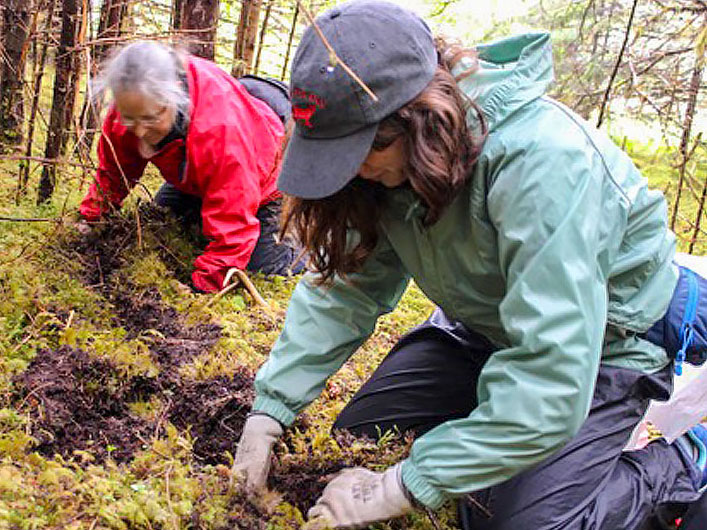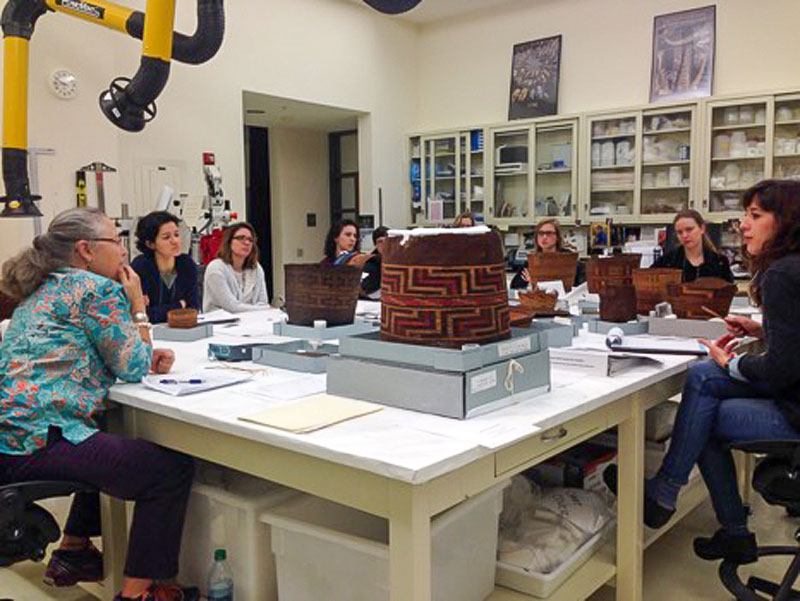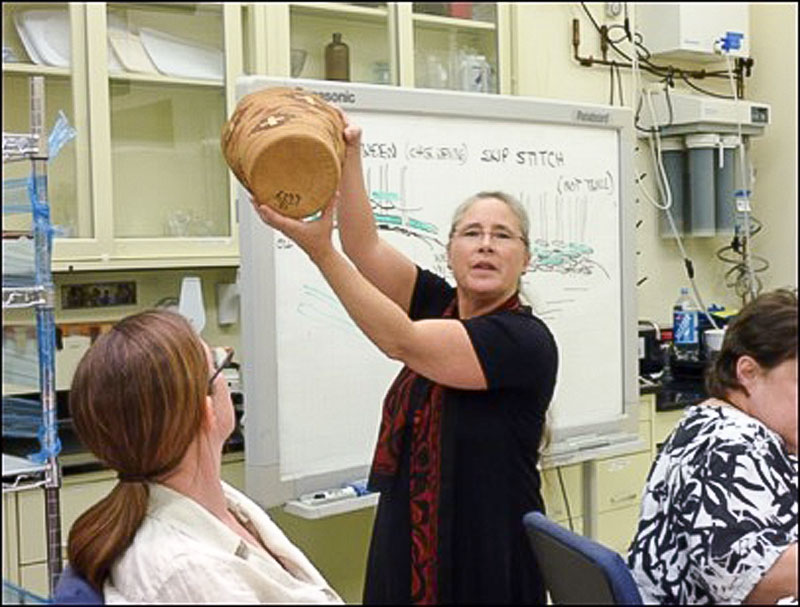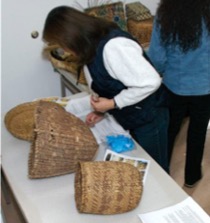Collaborative Conservation
CASE STUDY
NMAI Long-Term Collaborating with Tlingit Weaver Teri Rofkar (almost 30 years)
Landis Smith, National Museum of the American Indian
Tlingit weaver and artist Teri Rofkar has been associated with the National Museum of the American Indian (NMAI) since the early 1990s. When studying collections housed at NMAI’s Research Branch in the Bronx, she said: “It was a once in a life time experience. To spend time with the old ones in all of those collections … I was able to see the continuity and strength of the Tlingit arts! My work is forever changed … for the better!” Teri spoke of her research, saying: “I am following the steps of my Ancestors, striving to recapture the woven arts of an indigenous people. The ancient ways of gathering spruce root, with respect for the tree’s life and spirit, are a rich lesson in today’s world. Traditional methods of gathering and weaving natural materials help me link past, present and future. Links with a time when things were slower paced, a time when even a child’s berry basket was decorated with care. It is through sharing and exploring that this old art form shall take on new life.”
What began as an individual Native artist accessing, researching and learning from the Tlingit items in the NMAI (and other museum) collections, grew into larger collaborative experiences of sharing and exploring western and indigenous science together with conservators from the NMAI and other museums. The numerous perspectives and specialties of the group led to a better understanding of the effort and expertise needed to produce a basket and to the importance of basketry within the Tlingit culture. Importantly, Teri’s work with the NMAI culminated with the development of a protocol for the care and conservation of Tlingit baskets that is being shared with other museums.
Another result of collaborating with Teri, was the opportunity to co-author papers and co-present with her at conferences on basketry and conservation that discussed the indigenous science involved in basketry.

Teri Rofkar and NMAI Fellow Caitlin Mahony harvesting spruce roots in Sitka Alaska. 06/2016

Teri Rofkar and Caitlin Mahony hosting a conservation workshop on Tlingit Basketry 04/2016. From Left to Right: Teri Rofkar, Gabrielle Tieu, Anna Keruzec, Kate Blair, Diana Gabler, Evelyn Mayberger, and Caitlin Mahony

L to R: Samantha Alderson, Objects Conservator American Museum of Natural History, NYC, Teri Rofkar, Tlingit basket maker and weaver, Christina Davidson, NMAI program support staff. Learning about the native science of basketry construction.

L-R: Teri Rofkar, Michele Austin Dennehy and Susan Heald
CASE STUDY
Traditional Gutskin Repair
Kelly McHugh, National Museum of the American Indian
Included in the exhibition, “Living Our Cultures, Sharing Our Knowledge: The First People of Alaska” is a beautiful ceremonial gutskin parka from Saint Lawrence Island, which is presently part of the National Museum of the American Indian collection (123434.000). While examining the parka to make sure it could safely go on exhibition, it was noticed that several tears in the gut fabric were present and some of the crested auklet feathers used for decoration were missing. NMAI Conservator, Kelly McHugh, who was responsible for carrying out the conservation treatment on the Alaska Native items selected for loan, had very little experience working with gutskin.
As a membrane gut is very strong, but when dry it is can tear easily. Tears are often observed on parkas, and so are the repairs made to fix them. When in- use a common method of repair would be sewing a patch of gut with sinew around the torn area. A typical conservation repair in a museum would include gluing a patch, made out of Japanese tissue paper or Goldbeaters skin (calf intestine) around the torn area, with an archival adhesive. These glued repairs are not always successful and sometimes become detached, leaving reside of the glue on the gut fabric. Needing to talk with someone more familiar with the properties of gutskin in order to come up with the best way to repair the tears, the conservator was given the name of artist Elaine Kingeekuk. who comes from a family of skin sewers and uses gutskin in her own work.

Elaine Kingeekuk at work.
It was clear from the conversations with Ms. Kingeekuk, she was better qualified to do the treatment due to her familiarity and experience working with gut fabric. She traveled to the NMAI’s Cultural Resource Center in November of 2007 (?) after speaking about undertaking the repair of the parka with elders in Saint Lawrence Island and gathering the appropriate materials. The repairs were done in the traditional manner with gutskin patches sewn with sinew. Decorative auklet crests were reattached where necessary to complete the decorative design pattern. The treatment was documented through a written report and digital images. This case study shows that the expertise needed to responsibly care for an item in a museum collection may reside outside of the museum. The partnership between the conservator and the artist in discussing, executing and documenting the treatment resulted in the best care for this important garment.
CASE STUDY
Zuni Basket Project
Collaborative Conservation and Revitalization of Basketry in Community
Jim Enote and Nancy Odegaard
A:shiwi A:wan Museum and Heritage Center and Arizona State Museum
In 2010 the Arizona State Museum shared detailed images of the Zuni basketry objects from the collections and loan for use in a basketry weaving workshop held at the A:shiwi A:wan Museum and Heritage Center. Only two elder basketry weavers were known to have practical knowledge of traditional basket weaving. Members from the Zuni community worked with, Ruby Chimerica , a Hopi weaver to learn about basketry materials. They also learned about basketry material, when and where to gather them, how to prepare them, and as well as the methods of construction. The new weavers learned to work with wicker and plaiting techniques.

Several months later, the weaver group traveled to the Arizona State Museum for a collaborative workshop organized by Alyce Sadongei and held in the conservation lab with Nancy Odegaard. The entire collection of nearly 20 Zuni baskets was placed on tables so they could be handled and examined. The baskets were from acquired from multiple donations but the largest group included a baskets made in 1900-1925 that had come from E.C. Kelsey, a Zuni trader in 1953. Most of these baskets and others in the collection had seen considerable use prior to becoming part of the ASM collection. Details of the start, addition of new weaving elements, and the finish were highlighted and discussed. Plant material samples were compared to the basketry examples. An ethnobotanist, curator, and conservator were present to participate in the discussions of materials, museum records, and technology.
The use of collections by the new weavers resulted in new ideas about size, form, use, and tradition. Several individuals have continued to weave baskets, a discussion/presentation was made at a conference, and additional notes now accompany the museum records. Additionally, the conservators gained important insights towards preserving the past history in heritage baskets which has greatly influenced a major housing, storage room, and conservation stabilization project for the entire holding of basketry at the museum.

